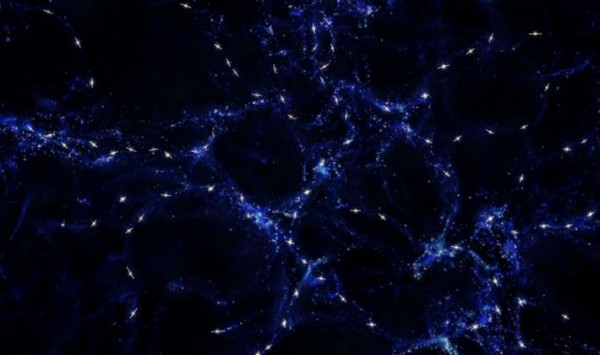Inexplicable Alignment of Black Holes Reveal Big Hole in the Big Bang
| Ana Verayo | | Nov 22, 2014 04:41 AM EST |
(Photo : ESO) Black hole's align in quasars
The universe has gotten a lot stranger and black holes are at the center of a new mystery that's baffling astronomers because it shouldn't be possible.
The European Southern Observatory in Garching, Germany announced that the rotation axes of supermassive black holes at the center of quasars it examined are parallel to each other over distances of billions of light-years.
Like Us on Facebook
Using its Very Large Telescope in Chile, an ESO a team led by Damien Hutsemékers of the University of Liège in Belgium studied 93 quasars that formed huge groupings billions of light-years wide.
These quasars are so far away astronomers are seeing them at a time when the universe was only one-third of its present age
Hutsemékers said the first odd thing they noticed was some of the quasars' rotation axes were aligned with each other despite the fact these quasars are billions of light-years apart.
He estimates the probability these alignments are simply the result of chance is less than 1%. Which explains the astonishment among astronomers at this discovery.
Intrigued, the team sought to find out if the rotation axes were linked, not only to each other but also to the structure of the universe on large scales at that time. Researchers found this to be so.
The results confirmed the rotation axes of the quasars tend to be parallel to the large-scale structures they inhabit.
The team's findings fly in the face of the accepted theories generated by the Big Bang. Some 13.8 billion years ago, the Big Bang created the universe in an explosion of matter and space that continues today.
Because the Big Bang is pushing galaxies outwards, it should be impossible that a quasar in one part of the universe should have a central supermassive black hole whose spin axis is aligned with that of another quasar billions of light-years away. But this is exactly what the ESO team discovered, much to their surprise.
The homogeneous matter spewed out by the Big Bang in all directions was basically the same but some of this matter began to clump. These clumps comprise the large-scale structure of the universe. This clumping also gave birth to galaxy superclusters.
Astronomers believe quasars to be highly luminous galaxies in the early universe. They also believe the quasars' great luminosity is caused by active supermassive black holes at the quasars' centers.
The alignments in the new data, on scales much larger than current predictions suggest there's a missing ingredient in current models of the universe.
TagsScientists Discover Order of the Universe Via Perfect Alignment of Black Holes in Quasars, quasars, Black Holes, very large telescope, pattern quasars black holes alignment
©2015 Chinatopix All rights reserved. Do not reproduce without permission
EDITOR'S PICKS
-

Did the Trump administration just announce plans for a trade war with ‘hostile’ China and Russia?
-

US Senate passes Taiwan travel bill slammed by China
-

As Yan Sihong’s family grieves, here are other Chinese students who went missing abroad. Some have never been found
-

Beijing blasts Western critics who ‘smear China’ with the term sharp power
-

China Envoy Seeks to Defuse Tensions With U.S. as a Trade War Brews
-

Singapore's Deputy PM Provides Bitcoin Vote of Confidence Amid China's Blanket Bans
-

China warns investors over risks in overseas virtual currency trading
-

Chinese government most trustworthy: survey
-

Kashima Antlers On Course For Back-To-Back Titles
MOST POPULAR
LATEST NEWS
Zhou Yongkang: China's Former Security Chief Sentenced to Life in Prison

China's former Chief of the Ministry of Public Security, Zhou Yongkang, has been given a life sentence after he was found guilty of abusing his office, bribery and deliberately ... Full Article
TRENDING STORY

China Pork Prices Expected to Stabilize As The Supplies Recover

Elephone P9000 Smartphone is now on Sale on Amazon India

There's a Big Chance Cliffhangers Won't Still Be Resolved When Grey's Anatomy Season 13 Returns

Supreme Court Ruled on Samsung vs Apple Dispute for Patent Infringement

Microsoft Surface Pro 5 Rumors and Release Date: What is the Latest?










